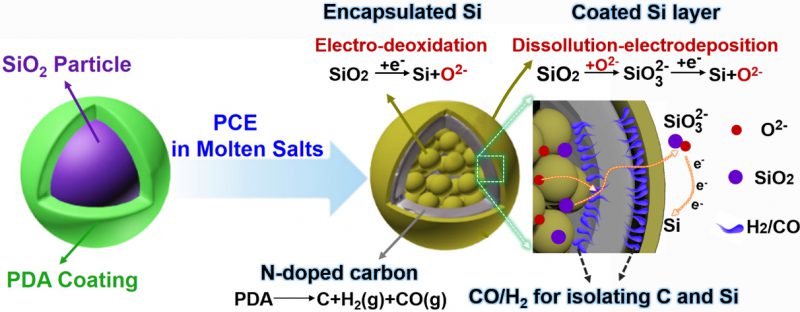Play in concert
To be commercially implemented, electrochemical reduction of silica in molten chlorides for Si extraction needs improvement in terms of productivity and functionality of electrolytic silicon. Wei Weng and Chen Zeng recently propose and demonstrate a one-pot electrochemical preparation of Si/C hybrids via Pyrolysis-Cum-Electrolysis (PCE) of SiO2@Polydopamine (SiO2@PDA) in molten NaCl-CaCl2 at 800 °C. In the PCE of the SiO2@PDA, PDA is pyrolyzed into N-doped carbon and SiO2 is simultaneously electro-deoxidized into Si. Pyrolysis of PDA results in gas evolution (viz. CO and H2) in the interface between Si and C species, functioning as a physical buffer between the generated Si and C to restrain formation of inconvenient SiC. The obtained hybrids, denoted as Si@C@Si, are composed of outmost silicon thin layers due to electrodeposition, sandwiched N-doped carbon hollow spheres derived from pyrolysis of PDA and encapsulated silicon nanoparticles stemming from direct electrodeoxidation of SiO2. The PCE protocol shows intriguing merits on accelerated electroreduction of SiO2 and retarded generation of inconvenient SiC. When evaluated as an anode for lithium ion batteries, the obtained Si@C@Si exhibits a reversible specific capacity of 904 mAh g-1 after 100 galvanostatic charge/discharge cycles at 500 mA g-1. The proposed PCE method is highlighted as an intensified Si extraction for advanced lithium ion batteries, promising practical applications. The above results are now accepted for publication in ACS Applied Materials & Interfaces.
Author: Professor Xiao